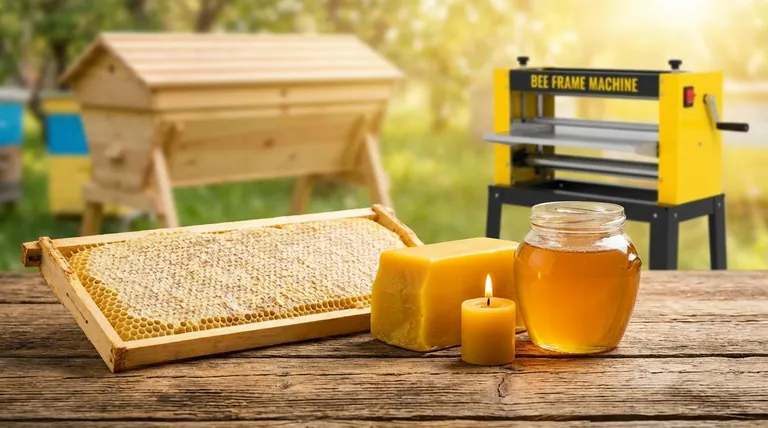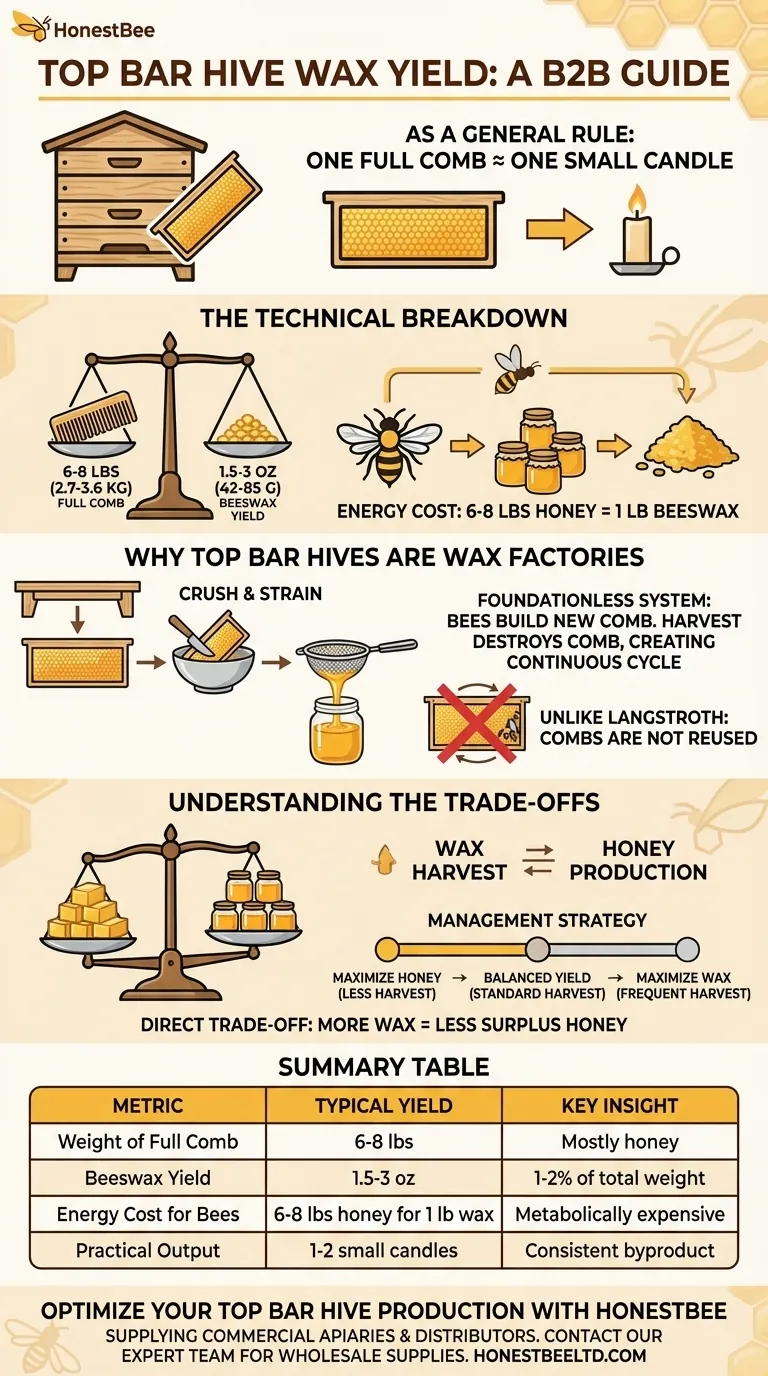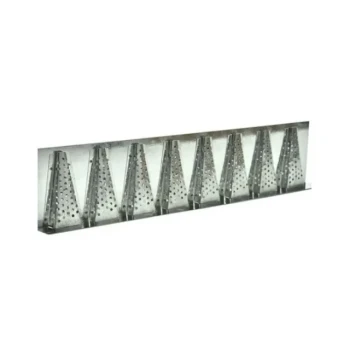As a general rule, a single, full comb from a top bar hive will yield enough beeswax to make one small candle. This is because the "crush and strain" method used for top bar hives harvests the entire comb, making wax a natural and consistent byproduct of honey extraction. The exact amount, however, depends on the comb's size and density.
The central takeaway is not the exact quantity of wax, but the inherent design of a top bar hive. Unlike other hive types where combs are reused, a top bar hive's process of harvesting honey always involves sacrificing the comb, making it a uniquely effective system for producing a steady supply of beeswax.

From Comb to Usable Wax: A More Precise Look
While "one candle" is a useful visual, a more technical breakdown reveals the true yield. Understanding the numbers allows you to forecast your harvest and manage your colony's resources effectively.
The Weight of a Full Comb
A typical, fully drawn-out comb filled with honey from a top bar hive can weigh between 6 to 8 pounds (2.7 to 3.6 kg). This weight is overwhelmingly honey, with the wax structure making up only a small fraction.
The True Wax Yield
Beeswax accounts for approximately 1-2% of the total weight of a harvested honey-filled comb. Therefore, an 8-pound comb will yield roughly 1.5 to 3 ounces (42 to 85 grams) of rendered beeswax. A standard, small taper or votive candle requires about 1-2 ounces of wax, making the "one candle per comb" estimate quite accurate for personal, small-scale use.
The Energy Cost of Wax
It's critical to understand that wax is metabolically expensive for bees to produce. The commonly accepted ratio is that bees must consume 6 to 8 pounds of honey to produce just 1 pound of beeswax. This energy expenditure is a key factor in hive management.
Why Top Bar Hives are Natural Wax Factories
The consistent wax yield from a top bar hive is a direct result of its management philosophy, which differs significantly from a standard Langstroth hive.
A Foundationless System
Top bar hives are foundationless. This means the beekeeper provides only a wooden top bar, often with a small guide, and the bees build the entire comb from scratch. Every cell is new, pure wax produced by the colony.
The "Crush and Strain" Harvest
To harvest honey, the beekeeper cuts the entire comb from the top bar. The comb is then cut up and crushed, and the honey is strained out. This process destroys the comb, leaving behind a mass of beeswax to be cleaned and rendered. In contrast, Langstroth beekeepers often uncap and spin the honey out, preserving the valuable drawn comb for the bees to reuse.
A Continuous Cycle
Because the oldest combs at the back of the hive are harvested, the bees are constantly encouraged to build new comb at the front. This creates a perpetual cycle of wax production and renewal that is fundamental to the top bar system.
Understanding the Trade-offs
Harvesting wax is not a "free" bonus; it represents a strategic choice that directly impacts the colony's resources and your potential honey yield.
Wax Harvest vs. Honey Production
There is a direct trade-off between wax production and honey surplus. When you harvest a comb, the bees must expend energy (and honey) to replace it. If they could have refilled a pre-existing comb instead, that energy would have been converted into more surplus honey for you.
Colony Strength and Timing
Aggressive wax harvesting should only be done with strong, thriving colonies during a robust nectar flow. Removing comb from a weak colony or during a nectar dearth forces the bees to use their precious winter stores to rebuild, potentially threatening their survival.
The Value Proposition
As a beekeeper, you must decide what is more valuable for your goals. If you need beeswax for candles, salves, or wood polish, the reduced honey yield may be an acceptable exchange. If your goal is maximizing honey production, you would harvest less frequently.
Making the Right Choice for Your Goal
Your management strategy should align with your primary objective. By understanding the trade-offs, you can guide your hive's output to match your needs.
- If your primary focus is maximizing honey surplus: Harvest less frequently, allowing bees to refill existing combs and dedicate more energy to foraging and storing nectar.
- If your primary focus is a balanced yield of wax and honey: Follow a standard top bar harvest plan, removing 2-3 combs from the rear of the hive once or twice a season to maintain a healthy production cycle.
- If your primary focus is maximizing wax production: Harvest more frequently from a very strong colony during peak season, knowing this will significantly reduce your total honey yield.
Ultimately, the top bar hive empowers you to choose whether to direct the colony's incredible energy toward storing honey or building wax.
Summary Table:
| Metric | Typical Yield | Key Insight |
|---|---|---|
| Weight of Full Comb | 6-8 lbs (2.7-3.6 kg) | Weight is mostly honey. |
| Beeswax Yield | 1.5-3 oz (42-85 grams) | Wax is 1-2% of total comb weight. |
| Energy Cost for Bees | 6-8 lbs of honey to make 1 lb of wax | Wax production is metabolically expensive. |
| Practical Output | Enough for 1-2 small candles | A consistent byproduct of the top bar system. |
Ready to optimize your top bar hive's production?
At HONESTBEE, we supply commercial apiaries and beekeeping equipment distributors with the high-quality, wholesale-focused supplies needed for success. Whether your goal is maximizing honey yield, wax production, or a balanced approach, our equipment and expertise can help you achieve it.
Let's discuss your specific needs. Contact our expert team today to get the right tools for your operation.
Visual Guide

Related Products
- HONESTBEE Bee Frame Grooving Machine | Precision Slotting for Bee Frame Making
- Professional Galvanized Hive Strap with Secure Locking Buckle for Beekeeping
- Professional Reversible Beehive Hive Entrance
- Langstroth Honey Bee Box Hive Boxes for Different Depths
- 5 Frame Wooden Nuc Box for Beekeeping
People Also Ask
- Why do beekeepers prefer crushed honey? Unlock a Richer, More Complex Flavor Profile
- What happens to honeycombs after harvest? Maximizing Resource Efficiency for Your Apiary
- When is the frame cleaning tool especially useful? Essential for Efficient Frame Reuse in Beekeeping
- What are the stages of development from egg to pupa in bees? A Guide to Bee Metamorphosis
- What should be the condition of the frames before harvesting honey? Achieve a Perfect Harvest with the 80% Capping Rule



















